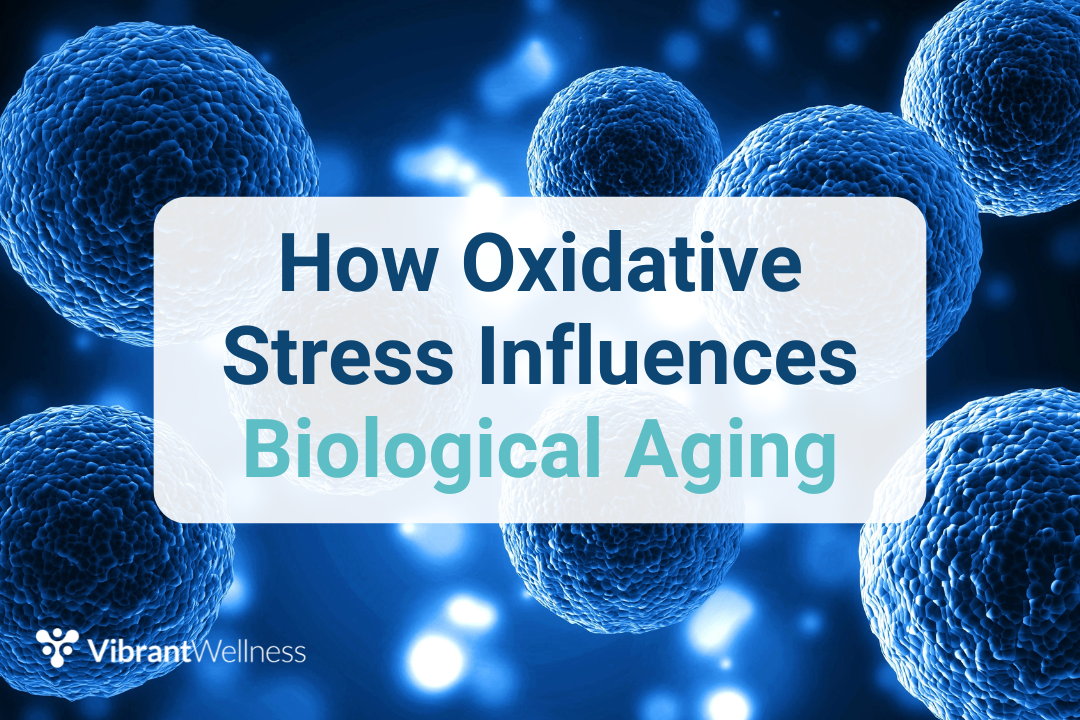The Impact of Genetics on Oxidative Stress
Oxidative stress is often cited as the mysterious driver of numerous diseases and conditions, including cardiovascular disease, diabetes, and many others.
As the name implies, oxidative stress refers to when the body is in a state of stress or inflammation. This occurs when there's an imbalance between the generation and buildup of reactive oxygen species (ROS) within cells and tissues and the ability of innate biological systems and dietary antioxidants to eliminate these reactive byproducts.
Several factors influence how we manage oxidative stress, including genetics—specifically certain single nucleotide polymorphisms that can cause decreased antioxidant activity and increased oxidative stress.
But how do our genetics influence the oxidative stress response?
Understanding these genetic aspects is vital for effective patient management and treatment strategies.
In this article, we’ll evaluate the role of oxidative stress genetics, the mechanisms they influence, the effects of oxidative stress, and how to utilize precision testing to create personalized treatment strategies for patients.
What is Oxidative Stress?

Oxidative stress refers to an overabundance of pro-oxidative factors and reactive oxygen species (ROS) compared to antioxidants.
Antioxidants are naturally present in many foods like fruits, vegetables, nuts, and whole grains. Common antioxidants include vitamins C and E, beta-carotene, selenium, and various phytochemicals.
These compounds help protect cells from oxidative stress and are believed to play a role in reducing the risk of chronic diseases, including certain types of cancer and cardiovascular diseases.
Additionally, the body produces its own antioxidants, such as superoxide dismutase (SOD), catalase, and glutathione, to maintain a balance and defend against oxidative damage.
One way antioxidants do this is by neutralizing ROS.
At moderate levels, ROS may play a role in cell signaling, including apoptosis, gene expression, and the activation of cell signaling cascades.
However, when there is an excess of these unstable molecules, their high reactivity can cause damaging chain reactions.
Reactive oxygen species are a type of free radical.
Free radicals are molecules with an unpaired electron, making them unstable. Molecules like this are looking to pair with or take electrons from other molecules or compounds.
In the process, they can wreak havoc on other substances in the body.
Excess free radicals can damage carbohydrates, lipids, proteins, and DNA.
When in a state of oxidative stress, the body is overwhelmed with free radicals and other ROS and doesn’t have enough antioxidants to combat them.
Over time, oxidative stress can lead to the development of various diseases and potentially speed up aging and inhibit longevity.
Conditions Associated with Oxidative Stress

Oxidative stress is linked to various conditions, including:
- Cardiovascular disease
- Diabetes
- Chronic kidney disease
- Neurodegenerative diseases
- Cancer
Many of the conditions associated with oxidative stress are age-related.
The exact relationship between oxidative stress and the aging process isn’t fully understood. However, there is strong evidence supporting the connection between oxidative stress and age-related disease development.
The generation of ROS may not be the cause of aging, but can amplify the aging process and exacerbate related diseases through oxidative damage and interactions with mitochondria.
Due to this connection, oxidative stress is becoming a more prominently known inhibitor of longevity.
One review, which looked at 12 different studies done on centenarians (individuals who live 100 years or more), demonstrated that this long-living group displays lower levels of oxidative stress than other elderly people.
Thus, in the fight for longevity, oxidative stress may play a crucial role.
What Are Oxidative Stress Genetics?

Oxidative stress genetics are single nucleotide polymorphisms that can influence an individual’s ability to handle oxidative stress in the body.
Levels of oxidative stress are impacted by mechanisms like enzyme production, antioxidant activity, mitochondrial function, cell signaling (reduction-oxidation molecules), and reactive oxygen species production, among others—all of which genetics can influence.
One major way the body defends itself against oxidative stress is through antioxidant enzymes such as catalase, superoxide dismutase (SOD), and glutathione peroxidase (GPx).

SOD2
SOD2 is an antioxidant enzyme primarily found in mitochondria and is the only one of its kind.
Individuals with a SNP in the gene that codes for SOD2 tend to have lower antioxidant activity, and thus, have higher levels of oxidative stress.
One study looked at the relationship between six different oxidative stress SNPs, including SOD2, and risk of stroke.
Oxidative stress can impact stroke risk by causing inflammation in the arterial atheromatous plaque and unstable atherosclerotic plaque formation, which eventually lead to stroke.
The SNPs involved include variations in the following genes:
- SOD2 (thymine to cytosine nucleotide change)
- CAT (adenine to thymine nucleotide change)
- GPX4 (thymine to adenine nucleotide change)
- NOS1 (cytosine to thymine nucleotide change)
- NOS2 (cytosine to thymine nucleotide change)
- NOS2 (guanine to cytosine nucleotide change)
The results showed a significant correlation between the SOD2 SNP and the occurrence of stroke.
Further, other research links this SNP to an increased risk of breast, prostate, bladder, and lung cancers, carotid atherosclerosis, and cardiomyopathy.
Other SNPs in the study that correlated with stroke risk include GPX4, NOS1, and NOS2.
Glutathione and GPX4

Glutathione is naturally produced by the body and is arguably the most influential antioxidant, as it helps preserve all other antioxidants.
Glutathione is one of the major antioxidants produced by cells whose job is to neutralize free radicals and reactive oxygen species and maintain antioxidants obtained through diet, such as vitamins C and E.
There are two forms of glutathione:
- The reduced form (GSH)
- The oxidized form (GSSG)
Glutathione works with its enzymes, glutathione peroxidase and glutathione reductase, to combat reactive oxygen species.
Genes that code for glutathione peroxidase enzymes include GPX1, GPX2, and GPX4. These enzymes work by using selenocysteine (an amino acid) as the active center to help reduce H2O2 or organic hydroperoxides to water or their corresponding alcohols.
This reduces their toxicity and maintains a proper balance of reactive oxygen species and antioxidants (or redox balance).
GPX4 can also reduce complex lipid compounds and is the only enzyme in the GPX family that directly reduces and destroys lipid hydroperoxides.
This enzyme is recognized as the key to destroying fatty acid hydroperoxides, which contribute to oxidative stress.
The body uses GPX4 for several important tasks. One of its main jobs is to protect cells from damage that can happen when fats in cell membranes break down (lipid peroxidation) due to exposure to free radicals.
GPX4 also helps regulate mitochondrial activity. Mitochondria create reactive oxygen species, and GPX4 helps manage these species and responds to changes they cause in cells, ensuring a balanced state in the body.
Variations in the gene can either cause aberrant redox signaling and increase reactive oxygen species, leading to oxidative stress, or lead to higher selenoprotein enzyme levels and reduced oxidative damage, depending on which variation you have.
Further, when there is an insufficiency or total absence of GPX4, it can lead to certain types of cell death.
Precision Testing Options for Oxidative Stress Genetics
To monitor the oxidative stress status of your patients, it’s necessary to understand each individual’s genetic background and predispositions for handling oxidative stress.
The best way to assess the exact SNPs involved in oxidative stress is through precision testing like Vibrant’s Oxidative Stress Profile.
This test detects 34 different SNPs and 25 additional markers of damage that impact oxidative stress status.
The SNPs will help determine if your patients have genetic predispositions for impaired antioxidant activity, mitochondrial dysfunction, aberrant redox signaling, increased selenoprotein concentrations, and additional factors influencing the body’s response to oxidative stress.
Assessing oxidative stress status is crucial in maintaining optimal health and longevity, as this mechanism in the body plays such a central role in age-related disease.
By understanding how well your patients manage oxidative stress, you can create personalized treatment options that cater to their needs and help them lead longer, healthier lives.
Oxidative Stress & Longevity

By looking at genetic make-up, we can better understand the resources our bodies have to fight damage linked to the aging process.
Understanding an individual's unique toolbox for oxidative stress can provide invaluable insights into their predisposition to age-related diseases and their overall aging trajectory.
Plus, using precision testing to detect oxidative stress status before disease development can potentially stop age-related illness in its tracks.
As we utilize genetics and learn more about the secrets to longevity, we move toward a future that offers more effective, targeted, and preventive treatments for age-related diseases.
With this knowledge at our disposal, we can maintain optimal health and begin the road toward correcting our bodies’ natural human shortcomings and achieving greater longevity.
Regulatory Statement:
The general wellness test intended uses relate to sustaining or offering general improvement to functions associated with a general state of health while making reference to diseases or conditions. This test has been laboratory developed and its performance characteristics determined by Vibrant America LLC and Vibrant Genomics, a CLIA-certified and CAP-accredited laboratory performing the test. The lab tests referenced have not been cleared or approved by the U.S. Food and Drug Administration (FDA). Although FDA does not currently clear or approve laboratory-developed tests in the U.S., certification of the laboratory is required under CLIA to ensure the quality and validity of the tests.
 By
By




